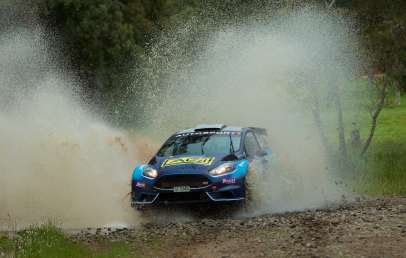Situated inside the service park at Australia’s biggest rally event are some of Australia’s brightest and most dedicated medical crews
Though an ideal weekend is a quiet one for medical volunteers, a state-of-the-art medical pod is ready for any eventuality.
“The role of the ‘Med Pod’ is basically to provide a medical facility for drivers, service crews and spectators here at service park, as well as providing a base if anyone needs a secondary check over having been injured out in the field,” Dr Stephen Gaggin said.
“Occasionally drivers will have an accident, finish a stage and continue but we like to catch up with them after an incident just to make sure they’re fit to continue competition.”

The pod is a well organised structure, ideally designed to be shipped to events across the country.
“The Med Pod is based on a container module that folds out. It provides two treatment beds with oxygen, suction, defibrillators, as well as all the various IV therapies etc.
“We also have a minor treatment bed on the other side of the screen there just for nicks, cuts and grazes,” Dr Gaggin said.
“So the ‘Med Pod’ just gives them a physical location to come to as opposed to trying to find someone. We’re backed up by the New South Wales Ambulance Service who have a permanent presence here while we are open.
“So if anything eventuates or we need paramedic assistance, we’re very well catered for.”

Dr Gaggin has been involved in motor sport events since the mid-1990s, and while he has scaled back his involvement he still enjoys the camaraderie amongst his professional colleagues.
“I started doing local events in Tasmania and then got into the Round Australia rallies when they were happening, Classic Outback Trials, Safaris, ARC rounds and a couple of world rounds. All up I’ve probably done 120 to 130 events over the years,” Dr Gaggin said.
“[Rally Australia], it’s a very big event, but you get a core of people who have the same interest and you build friendships around that interest.
“A lot of us practice in various guises in isolation and it’s actually really nice to come together and work as part of a team where it’s all about having the right people, with the right gear, in the right spot, at the right time. I really enjoy that side of it.”
Since his own early beginnings in the sport, Dr Gaggin has seen constant improvement in medical response and infrastructure in that time.
“We’re always trying to improve in that, you know, the days of trying to throw together gear to put in the back of some car and sit at a starting line, that sort of went out of vogue about 20 years ago. So in terms of equipment, rescue gear, logistics, and communications – it’s always evolving,” Dr Gaggin said.
“I’ve been part of the motor sport safety and rescue group ever since I’ve actually started doing it and it’s been great how that’s evolved over a period; in terms of the days where we raced around trying to put kits together, to now having beautifully pre-prepared kits.
“Everything is checked before they come to the event, everything’s in date, so it makes life a lot easier.”




